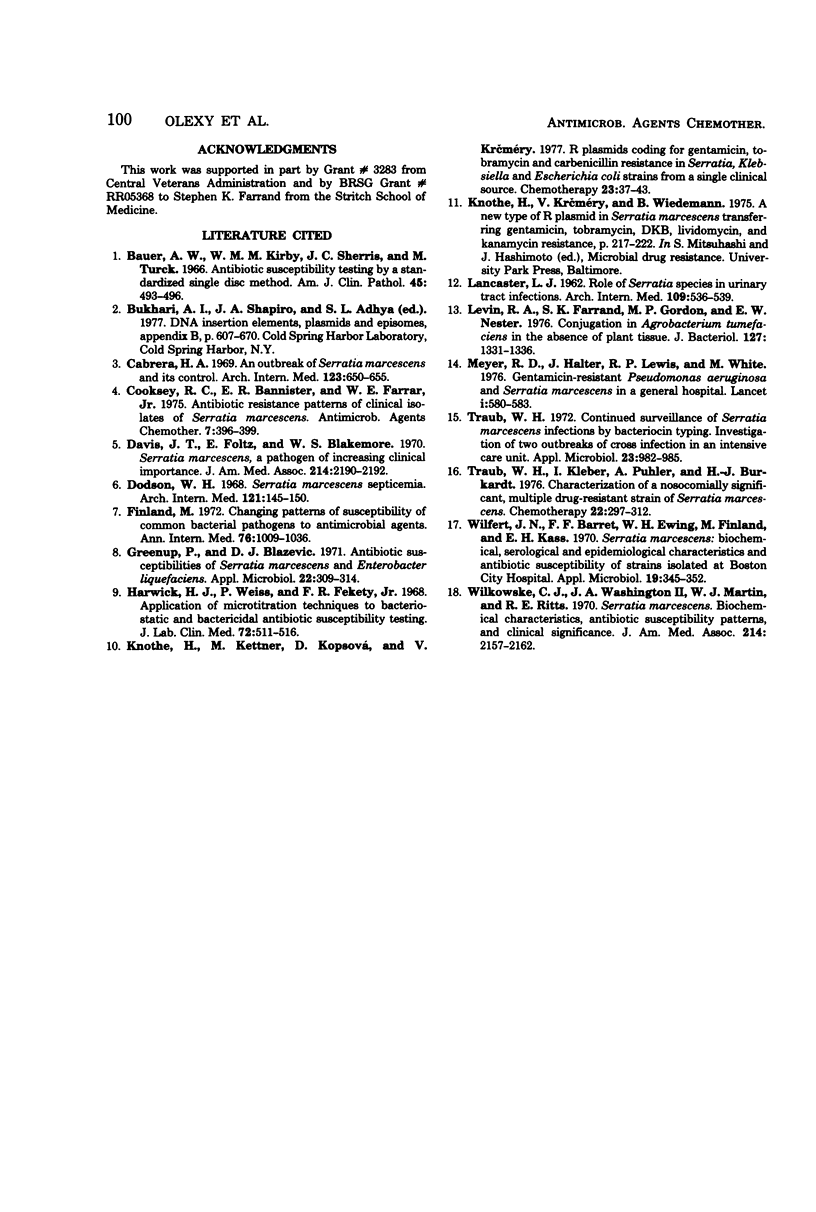Abstract
Thirteen independent isolates of Serratia marcescens associated with nosocomial urinary tract infections were obtained from the clinical microbiology laboratory at Hines Veterans Administration Hospital. The isolates were resistant to at least ampicillin, carbenicillin, gentamicin, and tobramycin. They could be divided into two groups on the basis of their antibiotypes. Group I (9 strains) showed resistance to 13 antibiotics, including 3 beta-lactams, 6 aminoglycosides, tetracycline, sulfonamide, trimethoprim, and polymyxin B. Group II (4 strains) was resistant to 11 antibiotics, including 3 beta-lactams, 5 aminoglycosides, sulfonamide, trimethoprim, and polymyxin B. Donors from both groups transferred resistance traits to Escherichia coli. Transconjugants from matings with group II donors all acquired resistance to nine antibiotics, including the three beta-lactams, five aminoglycosides, and sulfonamide. Transconjugants from matings with group I donors were of varied antibiotypes, inheriting resistance to up to 11 of the 13 antibiotics. Resistances to trimethoprim and polymyxin B were never observed to transfer. E. coli transconjugants of each group were capable of transferring multiple-antibiotic resistance to several other members of the family Enterobacteriaceae. All group II S. marcescens and E. coli donors and all group I S. marcescens donors transferred carbenicillin, streptomycin, kanamycin, gentamicin, tobramycin, and sisomicin resistance to Pseudomonas aeruginosa. The results suggest that these S. marcescens strains harbor R factors of a broader host range than previously reported.
Full text
PDF







Selected References
These references are in PubMed. This may not be the complete list of references from this article.
- Bauer A. W., Kirby W. M., Sherris J. C., Turck M. Antibiotic susceptibility testing by a standardized single disk method. Am J Clin Pathol. 1966 Apr;45(4):493–496. [PubMed] [Google Scholar]
- Cabrera H. A. An outbreak of Serratia marcescens, and its control. Arch Intern Med. 1969 Jun;123(6):650–655. [PubMed] [Google Scholar]
- Cooksey R. C., Bannister E. R., Farrar W. E., Jr Antibiotic resistance patterns of clinical isolates of Serratia marcescens. Antimicrob Agents Chemother. 1975 Apr;7(4):396–399. doi: 10.1128/aac.7.4.396. [DOI] [PMC free article] [PubMed] [Google Scholar]
- Davis J. T., Foltz E., Blakemore W. S. Serratia marcescens. A pathogen of increasing clinical importance. JAMA. 1970 Dec 21;214(12):2190–2192. doi: 10.1001/jama.214.12.2190. [DOI] [PubMed] [Google Scholar]
- Dodson W. H. Serratia marcescens septicemia. Arch Intern Med. 1968 Feb;121(2):145–150. [PubMed] [Google Scholar]
- Finland M. Changing patterns of susceptibility of common bacterial pathogens to antimicrobial agents. Ann Intern Med. 1972 Jun;76(6):1009–1036. doi: 10.7326/0003-4819-76-6-1009. [DOI] [PubMed] [Google Scholar]
- Greenup P., Blazevic D. J. Antibiotic susceptibilities of Serratia marcescens and Enterobacter liquefaciens. Appl Microbiol. 1971 Sep;22(3):309–314. doi: 10.1128/am.22.3.309-314.1971. [DOI] [PMC free article] [PubMed] [Google Scholar]
- Harwick H. J., Weiss P., Fekety F. R., Jr Application of microtitration techniques to bacteriostatic and bactericidal antibiotic susceptibility testing. J Lab Clin Med. 1968 Sep;72(3):511–516. [PubMed] [Google Scholar]
- Knothe H., Kettner M., Kopsová D., Krcméry V. R plasmids coding for gentamicin, tobramycin, and carbenicillin resistance in Serratia, Klebsiella and Escherichia coli strains from a single clinical source. Chemotherapy. 1977;23(1):37–43. doi: 10.1159/000221969. [DOI] [PubMed] [Google Scholar]
- LANCASTER L. J. Role of Serratia species in urinary tract infections. Arch Intern Med. 1962 May;109:536–539. doi: 10.1001/archinte.1962.03620170034005. [DOI] [PubMed] [Google Scholar]
- Levin R. A., Farrand S. K., Gordon M. P., Nester E. W. Conjugation in Agrobacterium tumefaciens in the absence of plant tissue. J Bacteriol. 1976 Sep;127(3):1331–1336. doi: 10.1128/jb.127.3.1331-1336.1976. [DOI] [PMC free article] [PubMed] [Google Scholar]
- Meyer R. D., Lewis R. P., Halter J., White M. Gentamicin-resistant Pseudomonas aeruginosa and Serratia marcescens in a general hospital. Lancet. 1976 Mar 13;1(7959):580–583. doi: 10.1016/s0140-6736(76)90370-6. [DOI] [PubMed] [Google Scholar]
- Traub W. H. Continued surveillance of Serratia marcescens infections by bacteriocin typing: investigation of two outbreaks of cross-infection in an intensive care unit. Appl Microbiol. 1972 May;23(5):982–985. doi: 10.1128/am.23.5.982-985.1972. [DOI] [PMC free article] [PubMed] [Google Scholar]
- Traub W. H., Kleber I., Pühler A., Burkardt H. J. Characterization of a nosocomially significant, multiple drug-resistant strain of Serratia marcescens. Chemotherapy. 1976;22(5):297–312. doi: 10.1159/000221937. [DOI] [PubMed] [Google Scholar]
- Wilfert J. N., Barrett F. F., Ewing W. H., Finland M., Kass E. H. Serratia marcescens: biochemical, serological, and epidemiological characteristics and antibiotic susceptibility of strains isolated at Boston City Hospital. Appl Microbiol. 1970 Feb;19(2):345–352. doi: 10.1128/am.19.2.345-352.1970. [DOI] [PMC free article] [PubMed] [Google Scholar]
- Wilkowske C. J., Washington J. A., 2nd, Martin W. J., Ritts R. E., Jr Serratia marcescens. Biochemical characteristics, antibiotic susceptibility patterns, and clinical significance. JAMA. 1970 Dec 21;214(12):2157–2162. doi: 10.1001/jama.214.12.2157. [DOI] [PubMed] [Google Scholar]


